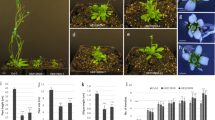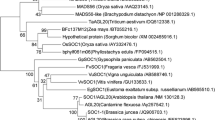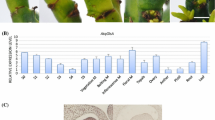Abstract
The double B-box (DBB) type zinc finger protein has thus far been shown to be involved in photomorphegenesis in Arabidopsis thaliana. Here, we show that DBB1a is expressed in the embryo, cytolden, and flower. Misexpression of DBB1a in mutant plants resulted in abnormal numbers and patterns of floral organs. We further show that DBB1a could regulate expression of several floral homeotic genes, including APETALA 2, APETALA 3, PISTILLATA, and AGAMOUS. Interestingly, expression of the microRNA gene MiR172, which is involved in organ boundary establishment, was also misregulated in the dbb1a mutant plants. Our study identified a previously uncharacterized role of DDB1a in regulation of expression of floral homeotic genes and miR172, which is important for understanding of floral pattern formation.






Similar content being viewed by others
References
Abe M, Kobayashi Y, Yamamoto S, Daimon Y, Yamaguchi A, Ikeda Y, Ichinoki H, Notaguchi M, Goto K, Araki T (2005) FD, a bZIP protein mediating signals from the floral pathway integrator FT at the shoot apex. Science 309:1052–1056
Ang LH, Deng XW (1994) Regulatory hierarchy of photomorphogenic loci: allele-specific and light-dependent interaction between the HY5 and COP1 loci. Plant Cell 6:613–628
Chae E, Tan QKG, Hill TA, Irish VF (2008) An Arabidopsis F-box protein acts as a transcriptional co-factor to regulate floral development. Development 135:1235–1245
Chen X (2004) A MicroRNA as a translational repressor of APETALA2 in Arabidopsis flower development. Science 303:2022–2025
Coen ES, Meyerowitz EM (1991) The war of the whorls: genetic interactions controlling flower development. Nature 353:31–37
Datta S, Hettiarachchi C, Johansson H, Holm M (2007) SALT TOLERANCE HOMOLOG2, a B-box protein in Arabidopsis that activates transcription and positively regulates light-mediated development. Plant Cell 19:3242–3255
Datta S, Johansson H, Hettiarachchi C, Irigoyen ML, Desai M, Rubio V, Holm M (2008) LZF1/SALT TOLERANCE HOMOLOG3, an Arabidopsis B-box protein involved in light-dependent development and gene expression, undergoes COP1-mediated ubiquitination. Plant Cell 20:2324–2338
Desfeux C, Clough SJ, Bent AF (2000) Female reproductive tissues are the primary target of Agrobacterium-mediated transformation by the Arabidopsis floral-dip method. Plant Physiol 123:895–904
Elmayan T, Balzergue S, Beon F, Bourdon V, Daubremet J, Guenet Y, Mourrain P, Palauqui J-C, Vernhettes S, Vialle T, Wostrikoff K, Vaucheret H (1998) Arabidopsis mutants impaired in cosuppression. Plant Cell 10:1747–1758
Irish VF (2008) The Arabidopsis petal: a model for plant organogenesis. Trends Plant Sci 13:430–436
Jens F, Sundstron NNKGVFI (2006) Direct regulation of the floral homeotic APETALA1 gene by APETALA3 and PISTILLATA in Arabidopsis. Plant J 46:593–600
Jung J-H, Seo Y-H, Seo PJ, Reyes JL, Yun J, Chua N-H, Park C-M (2007) The GIGANTEA-regulated MicroRNA172 mediates photoperiodic flowering independent of CONSTANS in Arabidopsis. Plant Cell 19:2736–2748
Kramer EM, Dorit RL, Irish VF (1998) Molecular evolution of genes controlling petal and stamen development: duplication and divergence within the APETALA3 and PISTILLATA MADS-box gene lineages. Genetics 149:765–783
Krizek BA, Meyerowitz EM (1996) The Arabidopsis homeotic genes APETALA3 and PISTILLATA are sufficient to provide the B class organ identity function. Development 122:11–22
Kumagai T, Ito S, Nakamichi N, Niwa Y, Murakami M, Yamashino T, Mizuno T (2008) The common function of a novel subfamily of B-box zinc finger proteins with reference to circadian-associated events in Arabidopsis thaliana. Biosci Biotechnol Biochem 72:1539–1549
Lamb RS, Hill TA, Tan QKG, Irish VF (2002) Regulation of APETALA3 floral homeotic gene expression by meristem identity genes. Development 129:2079–2086
Li Zhao YKTTDXC (2007) miR172 regulates stem cell fate and defines the inner boundary of APETALA3 and PISTILLATA expression domain in Arabidopsis floral meristems. Plant J 51:840–849
Lin C (2002) Blue light receptors and signal transduction. Plant Cell 14:S207–225
Lohmann JU, Weigel D (2002) Building Beauty: the genetic control of floral patterning. Dev Cell 2:135–142
Mizoguchi T, Wright L, Fujiwara S, Cremer F, Lee K, Onouchi H, Mouradov A, Fowler S, Kamada H, Putterill J, Coupland G (2005) Distinct roles of GIGANTEA in promoting flowering and regulating circadian rhythms in Arabidopsis. Plant Cell 17:2255–2270
Nag A, Yang Y, Jack T (2007) DORNRÖSCHEN-LIKE, an AP2 gene, is necessary for stamen emergence in Arabidopsis. Plant Mol Biol 65:219–232
Nagaoka S, Takano T (2003) Salt tolerance-related protein STO binds to a Myb transcription factor homologue and confers salt tolerance in Arabidopsis. J Exp Bot 54:2231–2237
Ohno CK, Reddy GV, Heisler MGB, Meyerowitz EM (2004) The Arabidopsis JAGGED gene encodes a zinc finger protein that promotes leaf tissue development. Development 131:1111–1122
Putterill J, Robson F, Lee K, Simon R, Coupland G (1995) The CONSTANS gene of Arabidopsis promotes flowering and encodes a protein showing similarities to zinc finger transcription factors. Cell 80:847–857
Richmond TA, Bleecker AB (1999) A Defect in {beta}-oxidation causes abnormal inflorescence development in Arabidopsis. Plant Cell 11:1911–1924
Siddhartha Kanrar MBBAJCHMSS (2008) Regulatory networks that function to specify flower meristems require the function of homeobox genes PENNYWISE and POUND-FOOLISH in Arabidopsis. Plant J 54:924–937
Smyth DR, Bowman JL, Meyerowitz EM (1990) Early flower development in Arabidopsis. Plant Cell 2:755–767
Wenkel S, Turck F, Singer K, Gissot L, Le Gourrierec J, Samach A, Coupland G (2006) CONSTANS and the CCAAT box binding complex share a functionally important domain and interact to regulate flowering of Arabidopsis. Plant Cell 18:2971–2984
Wigge PA, Kim MC, Jaeger KE, Busch W, Schmid M, Lohmann JU, Weigel D (2005) Integration of spatial and temporal information during floral induction in Arabidopsis. Science 309:1056–1059
Yang Meiying HHWYGQFLZX (2007) Construction of efficient gene silencing vector harboring lycopene β-cyclase gene. Mol Plant Breeding 5:43–46
Zhang X, Henriques R, Lin S-S, Niu Q-W, Chua N-H (2006) Agrobacterium-mediated transformation of Arabidopsis thaliana using the floral dip method. Nat Protocols 1:641–646
Acknowledgments
Thanks to Dr. Bekir Ulker and Dr. JaneParker for kindly providing pJawohl8-RNAi, and Dr. Ying Ruan and Wenhui Shen for his critical reading of the manuscript. This research was supported by the grants from National Natural Science Foundation of China (30600368; 30770200; 30871325).
Author information
Authors and Affiliations
Corresponding author
Rights and permissions
About this article
Cite this article
Wang, Q., Tu, X., Deng, K. et al. A Defect in Zinc Finger Protein Double B-box 1a (DBB1a) Causes Abnormal Floral Development in Arabidopsis . J. Plant Biol. 52, 543–549 (2009). https://doi.org/10.1007/s12374-009-9070-6
Received:
Accepted:
Published:
Issue Date:
DOI: https://doi.org/10.1007/s12374-009-9070-6




